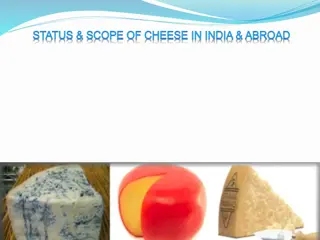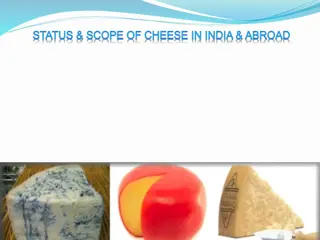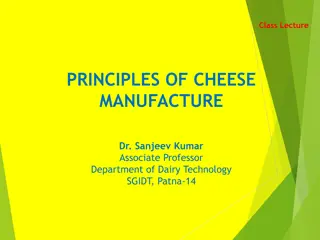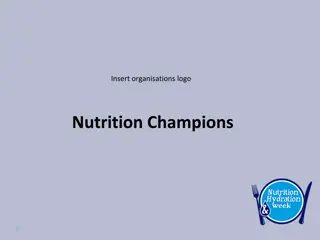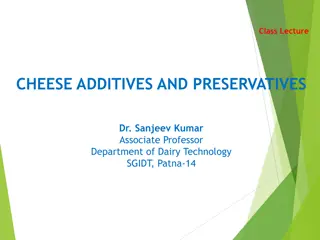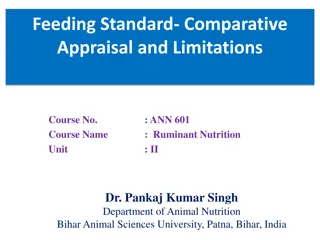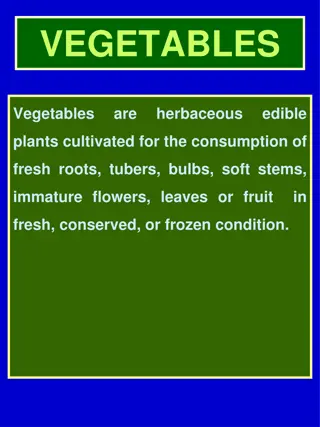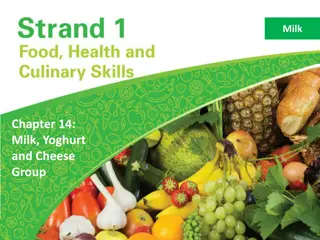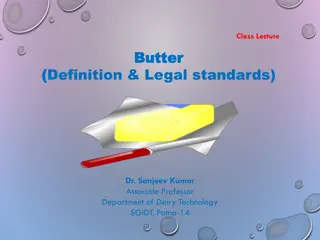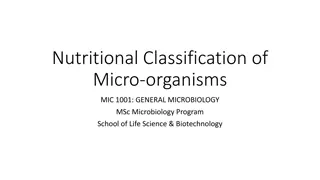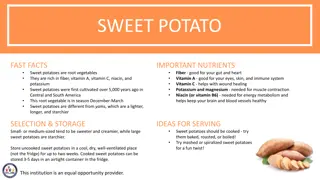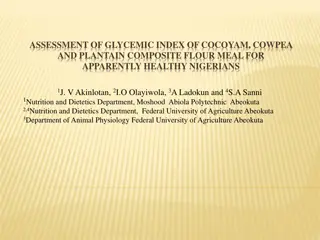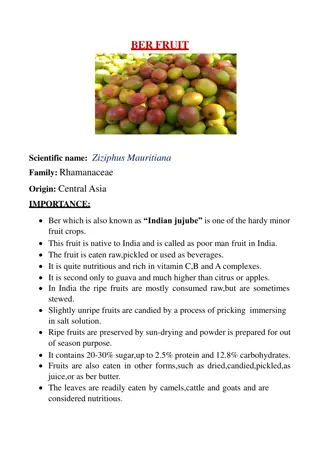Understanding Cheese: Technology, Classification, Legal Standards, and Nutritional Value
Dive into the world of cheese with insights on its technology, definitions, classification, legal standards, and nutritional composition. Discover how cheese is made, categorized, regulated, and its key nutritional components.
Download Presentation

Please find below an Image/Link to download the presentation.
The content on the website is provided AS IS for your information and personal use only. It may not be sold, licensed, or shared on other websites without obtaining consent from the author. Download presentation by click this link. If you encounter any issues during the download, it is possible that the publisher has removed the file from their server.
E N D
Presentation Transcript
Cheese Technology Dr Sanjeev Kumar Associate Professor Department of Dairy Technology
Definition Cheese may be defined as the curd of milk separated from the whey and pressed into a solid mass . Cheese is the fresh or matured solid or semi-solid product obtained: ----- By coagulating milk, skim milk or partly skimmed milk, whey, cream or butter milk or any combination of these materials, through the action of rennet or other suitable coagulating agents and by partially draining the whey resulting from such coagulation, or -------- By processing techniques involving coagulation of milk and/or materials obtained from milk (provided that the whey protein casein ratio does not exceed that of milk) and which give an end product which has similar physical, chemical or organoleptic characteristics as the product defined under (a).
Classification of Cheese Very hard (grating) - Moisture < 35% on matured cheese and ripened by bacteria, e.g. Parmesan, Romano. Hard - Moisture < 40% a) Ripened by bacteria, without eyes: Cheddar b) Ripened by bacteria, with eyes: Swiss Semi-hard - Moisture 40-47% a) Ripened principally by bacteria: Brick b) Ripened by bacteria and surface microorganisms: Limburger c) Ripened principally by blue mould: i) External Camembert ii) Internal Gorgonzola, Blue, Roquefort. Soft - Moisture > 47% a) Unripened Cottage b) Ripened Neufchatel
Legal standards for cheeses Type of cheese Moisture, maximum Milk Fat on Dry basis Hard Pressed Cheese Not more than 39.0 percent Not less than 48.0 Semi Hard Cheese Not more than 45.0 percent Not less than 40.0 percent Semi Soft Cheese Not more than 52.0 percent Not less than 45.0 percent Soft Cheese Not more than 80.0 percent Not less than 20.0 percent Extra Hard Cheese Not more than 36.0 percent Not less than 32.0 percent Mozzarella Cheese Not more than 60.0 percent Not less than 35.0 percent Pizza Cheese Not more than 54.0 percent Not less than 35.0 percent
COMPOSITION AND NUTRITIONAL VALUE OF CHEESE Nutritional composition --- determined by the type of milk used (species, breed, stage of lactation, and fat content) and the manufacturing and ripening procedures. Cheese --- rich in the fat and casein constituents of milk, which are retained in the curd during manufacture Contains relatively small amounts of the water soluble constituents (whey proteins, lactose, and water-soluble vitamins), which partition mainly into the whey.
PROTEIN Cheese contains a high content of biologically valuable protein Protein content of cheese ranges from approximately 4-40%, depending upon the variety Cheese protein ---- almost 100% digestible, as the ripening phase of cheese manufacture involves a progressive breakdown of casein, to water-soluble peptides and free amino acids LIPIDS Fat affects cheese firmness, adhesiveness, mouthfeel and flavour and also provides nutrition. Cheese fat generally contains 66% saturated, 30% monounsaturated and 4% polyunsaturated fatty acids
Carbohydrate Principal carbohydrate in milk is lactose, most of which lost in whey during cheese manufacture. Cheese --- therefore, a safe food for lactose-intolerant people. Vitamins and Minerals Fat soluble vitamins remain in the curd ----- most of the water soluble vitamins are lost in whey Most cheeses --- good sources of vitamin A, riboflavin, vitamin B12, and, to a lesser extent, folate Good source of bioavailable calcium, with most hard cheeses containing approximately 800 mg calcium/100 g cheese Calcium intake during childhood and in teenage years --- important in development of high bone mass which may prevent osteoporosis .
SELECTION OF MILK Cheese milk is usually pasteurized or subjected to alternate treatments to render it free of pathogenic, food poisoning and/or spoilage bacteria. World famous cheeses ---- produced from sheep s milk, e.g. Roquefort and Feta and Romano; Mozzarella ---- made from buffalo milk. Mammals containing a higher proportion of C6-C10fatty acids would develop a characteristic peppery flavor, as seen in Roquefort, which is always made from sheep milk INHIBITORY SUBSTANCES IN MILK All cheeses depend on the growth of lactococci and all matured cheese depends on the development of lactobacilli. Lactenin found in milk may inhibit the growth of certain streptococci. Lactenin ---------two components, L1 and L2. L1 ---- present in colostrum and is inactivated by heating to 70 C /20 min L2-- present in mid-lactation milk and is inactivated by heating to 70 C/ 20 min.
Storage of Chilled Milk Milk for cheese ---- normally chilled to 4-5 C immediately after milking Standardization of Milk Fat and casein together with moisture left in the curd control cheese yield, but fat also has a marked influence on appearance and feel of the curd and cheese. Casein: fat ratio (C/F ratio) in milk should be about 0.7 for good quality cheese Heat Treatment of Milk Cheese made from raw milk develops more intense flavor than that produced from pasteurized milk, Thermization of cheese milk is fairly widely practiced ---------to reduce the microbial load and extend the storage period. Thermization (65 C/15 s) of cheese milk on arrival on factory ---- common or standard practice in some countries Objective ------- to control psychrotrophs and milk is normally pasteurized before cheese making
RIPENING OF MILK (ACIDIFICATION) Increase in acidity in the milk to be used for cheese making known as ripening --- usually brought about by Starter culture. Acidification is normally via in situ production of lactic acid, although preformed acid or acidogen (gluconic acid- -lactone) ----- now used to directly acidify curd for some varieties, e.g. Mozzarella cheese, UF Feta and Cottage. Add a culture (starter) of selected lactic acid bacteria to pasteurized cheese milk to achieve a uniform and predictable rate of acid production. COAGULATION Coagulation may be achieved: Limited proteolysis by selected proteinases (Rennets) Acidification to pH 4.6 Acidification to pH 5.2 and heating to 90 C. 75% of total production, ---- Produced by rennet coagulation but some acid coagulated varieties, e.g. Quark and Cottage cheese, Rennin is an extremely powerful clotting enzyme; one part of pure rennin can clot more than five million parts of milk.
The optimum pH for rennin action on milk -- 5.4 and for pepsin ----- 2.0. Hard cheese such as Cheddar, usually about 2.5 g of commercial rennet powder is used for 100 l of milk. In case of Meito rennet -----1.25 to 1.65 g/100 l milk. Formation of curd depends upon the coagulation of the casein in milk. With rennet this occurs in two steps. The calcium caseinate in milk ---- first changed to the paracasein, which then combines with the calcium ions present in the milk to form an insoluble curd. Addition of small amount (0.02%) of calcium chloride to the milk usually will restore the calcium ion balance and permit the normal functioning of rennin.
CUTTING THE COAGULUM The coagulum ----- ready to cut after a period of from 25 min to 2 h Clear cleavage with green whey at the base of the cleft ------ the curd is ready to cut. Soft irregular cleavage with white whey indicates that the curd is too soft. When curd is ready for cutting, it is first cut horizontally and then vertically. Surface-active materials such as phospholipids and whey proteins accumulate on the cut surface and form a thin osmotic membrane. This membrane controls the whey expulsion during cooking COOKING Cooking or scalding the curd causes the protein matrix to shrink and expel more whey High acid curds (i.e. blue veined cheese curds) lose more calcium (92%) than low acid curds such as Edam (35%) The aim of scalding the curd ------ to shrink the curd to expel moisture and so firm up the curd to a state ready for texture formation, pressing or salting.
CURD TREATMENT The manner in which the whey is drained from the curd varies with the kind of cheese Cream cheese, for example, is prepared by placing the curd on cloths which allow the whey to drain away. Sometimes the curd is placed in forms or hoops put on mats or coarsely woven screens which allow the whey to drain as in the manufacture of Brick cheese, In the making of Cheddar cheese, curd ---- allowed to sink in the vat and the supernatant whey is drawn off, In making Swiss cheese, the curd is separated by placing a cloth under the curd and lifting it out of the vat or kettle. PRESSING Last portion of the whey is removed from the curd by pressing. The pressure applied to the cheese should be per unit area of the cheese and not per cheese, which may vary with size cheese curd holds a volume of air before pressing, those cheeses requiring very closed curds (e.g. Cheddar) ------- pressed under a vacuum of 85-95 kN/m2 (25-28 in Hg). Pressures ---- traditionally applied for 2-3 days to Cheddar cheese,
TREATMENT OF RIND Growth of mold on Camembert and Roquefort type cheeses, Growth of yeasts and bacteria on Brick and Limburger cheeses. Soft types of cheese acquire a rind during ripening, often as a result of the growth of molds and bacteria Cheeses ---- ripe and ready for sale, the rind is simply coated with vegetable (olive) oil, which ----- colored brown or black (e.g. Parmesan, Romano). Gorgonzola --------coated with Plaster of Paris as a protective coat inside a woven basket Feta and similar cheeses ------- packed in casks or drums filled with brine or salted whey.
SALTING Salting of perishable foods is among the most ancient and widely practiced techniques of food preservation Common salt (NaCl) is an ingredient of practically every variety of cheese. Actual level of salt in cheese varies with the type, ranging from 0.5% to about 3% (w/w) Methods of salting Three main techniques for salting of cheese Mixing of dry salt crystals with subdivided cheese curds prior to the moulding/pressing stage of manufacture, Immersion of the moulded cheese in a brine solution, Application of dry salt or salt slurry to the surface of the formed cheese.



